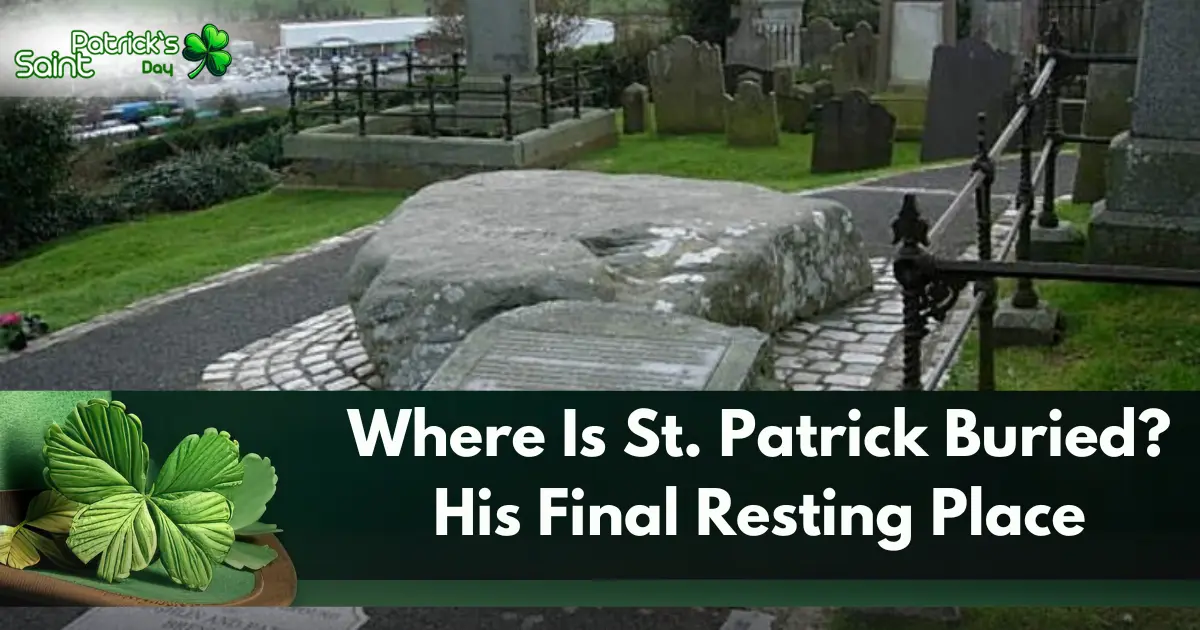Saint Patrick, Ireland’s patron saint, is believed to be buried at Down Cathedral in Downpatrick, Northern Ireland. This historical site is widely recognized as his final resting place, marked by a large stone slab.
St. Patrick’s burial has been a topic of discussion for centuries. While legends and myths surround his life, Down Cathedral remains the most accepted site. But why was he buried there? Let’s explore the history and evidence behind this significant location.
The Final Resting Place of St. Patrick | Down Cathedral
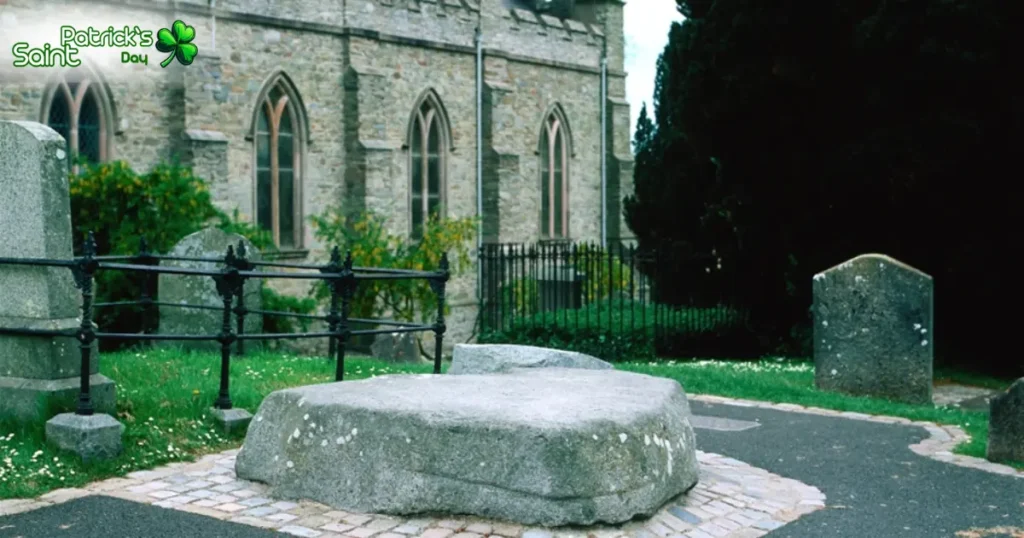
The Significance of Down Cathedral
Down Cathedral, located in Downpatrick, County Down, is an iconic landmark in Irish history. It sits on the Hill of Down, where St. Patrick is traditionally believed to be buried. This historic church has been a pilgrimage site for centuries, attracting visitors from around the world.
How Do We Know St. Patrick Was Buried Here?
There is no official contemporary record of St. Patrick’s burial, but several historical sources support the claim that he was buried in Downpatrick:
- Medieval Manuscripts: Ancient texts, including the Annals of Ulster, mention Downpatrick as his burial site.
- Local Tradition: Irish oral history has long associated the site with St. Patrick.
- 19th-Century Marking: A large granite stone was placed at the site in 1900 to mark his grave, based on strong local and historical evidence.
Description of St. Patrick’s Grave
St. Patrick’s grave is simple yet significant:
- A large granite stone slab marks the site, placed in 1900.
- Engraved with “Patric”, the stone signifies his resting place.
- Located near the cathedral, surrounded by historical monuments.
Other Saints Buried With St. Patrick?
Tradition suggests that St. Brigid and St. Columba, two other significant Irish saints, are also buried in Downpatrick. While exact details remain unclear, their association adds to the site’s spiritual importance.
Historical Evidence of St. Patrick’s Burial
Historians have debated the authenticity of St. Patrick’s burial site. Let’s examine the evidence supporting Down Cathedral:
1. Early Irish Records
- The Annals of Ulster (9th century) reference Downpatrick as St. Patrick’s burial place.
- The Book of Armagh (7th century) also mentions the location.
2. Archaeological Evidence
- Excavations near the cathedral have uncovered medieval graves and church foundations, aligning with early historical texts.
- The granite stone marking the grave was confirmed by local historical records.
3. Religious Traditions
- Down Cathedral has been a pilgrimage site for centuries, drawing people who believe in the sacred significance of St. Patrick’s grave.
- The Roman Catholic and Anglican Churches recognize Down Cathedral as the official burial site.
Is There an Alternative Burial Site?
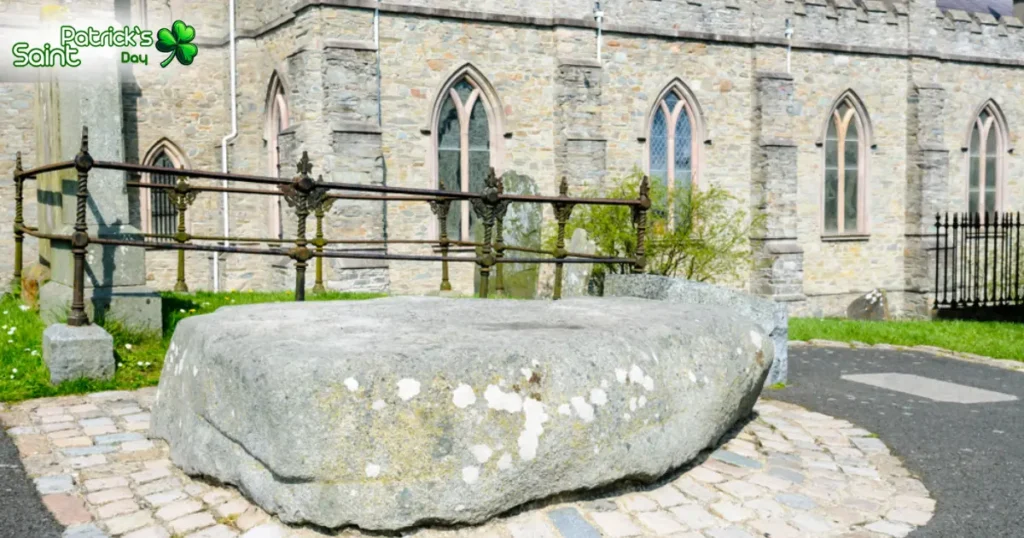
While Down Cathedral is the most widely accepted location, some theories suggest alternative burial sites:
1. Glastonbury Abbey, England
- Some medieval records claim that St. Patrick returned to England in his later years and was buried in Glastonbury Abbey.
- This theory is widely disputed, as Irish historical texts strongly favor Downpatrick.
2. Armagh, Ireland
- Another belief suggests that St. Patrick was buried in Armagh, the religious center he established.
- However, no archaeological evidence supports this claim.
The History Behind St. Patrick’s Burial
St. Patrick’s Death: When and Where Did He Die?
St. Patrick is believed to have died on March 17, 461 AD. This date is now celebrated worldwide as St. Patrick’s Day. Historical accounts suggest he died in Saul, County Down, Ireland, where he had established a church.
Why Was St. Patrick Buried in Downpatrick?
After St. Patrick’s death, his followers had to decide on a burial site. The following reasons explain why Downpatrick was chosen:
1️⃣ Religious Importance: Downpatrick was a major religious center in early medieval Ireland.
2️⃣ Close to Saul Church: The place where St. Patrick died was near Downpatrick, making it a natural choice.
3️⃣ A Pilgrimage Destination: The site later became a center for Christian pilgrimage in Ireland.
Who Buried St. Patrick?
According to historical texts, St. Patrick’s followers, including monks and local leaders, buried him in Downpatrick with great honor and ceremony. His funeral was attended by many religious figures of the time.
Legends and Myths About St. Patrick’s Burial
Like many historical figures, St. Patrick’s death and burial are surrounded by myths and legends. Some of the most famous stories include:
1. The Battle Over His Body
One legend claims that after St. Patrick’s death, two groups—those from Armagh and Downpatrick—disputed where he should be buried. To resolve the conflict, a divine light appeared in the sky, leading them to Downpatrick.
2. The Disappearance of His Grave
Some medieval texts claim that St. Patrick’s grave was forgotten for centuries until it was rediscovered in the 12th century by monks who followed an old prophecy.
3. The Stone Marking His Grave
- The large granite stone at Down Cathedral was placed in 1900 to mark his burial site.
- This stone was sourced from the Mourne Mountains, which are deeply connected to Irish heritage.
4. The Prophecy of Three Saints
According to another legend, St. Patrick, St. Brigid, and St. Columba were all buried together in Downpatrick, fulfilling an ancient prophecy.
Cultural and Religious Importance of St. Patrick’s Grave
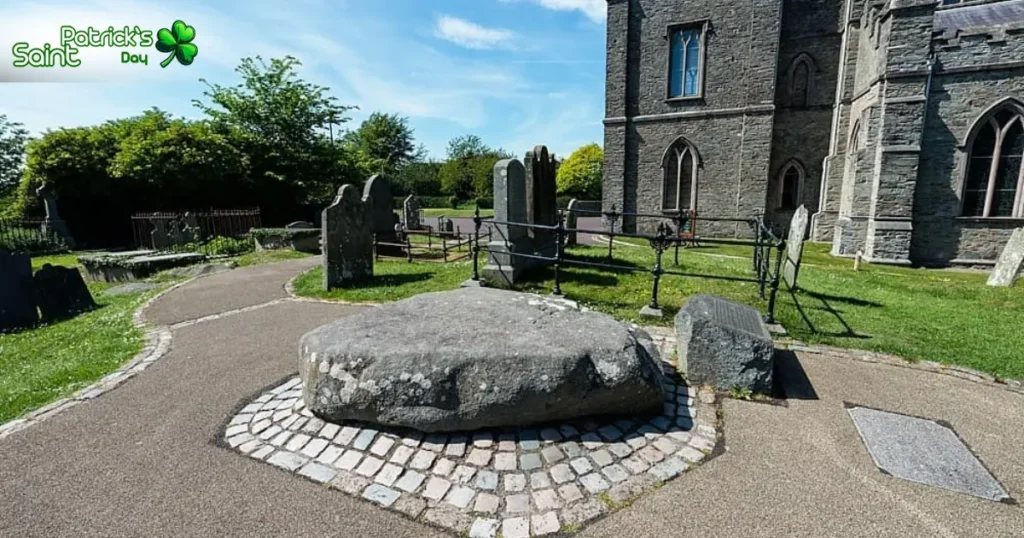
St. Patrick’s burial site is not just a historical location—it is a place of deep religious and cultural significance.
1. A Major Pilgrimage Site
- For centuries, Down Cathedral has been a holy site for Christians.
- Pilgrims visit St. Patrick’s grave to honor his legacy and seek blessings.
2. Influence on Irish Identity
- St. Patrick’s burial site symbolizes the spread of Christianity in Ireland.
- His grave is a national landmark, representing Irish faith and heritage.
3. Annual St. Patrick’s Day Celebrations
- Every March 17th, thousands visit Down Cathedral to pay tribute to St. Patrick.
- The site hosts religious ceremonies, parades, and cultural events.
4. Recognition by Religious Institutions
- The Roman Catholic and Anglican Churches recognize Down Cathedral as St. Patrick’s official burial site.
- Popes and religious leaders have visited the grave to honor his contribution to Christianity.
Visiting St. Patrick’s Burial Site: A Pilgrim’s Experience
Where Exactly Is St. Patrick’s Grave Located?
St. Patrick’s burial site is within the grounds of Down Cathedral in Downpatrick, County Down, Northern Ireland. It is easily accessible to visitors.
📍 Exact Location:
- Address: Down Cathedral, English Street, Downpatrick, Northern Ireland
- Coordinates: 54.3261° N, 5.7188° W
What Can Visitors See at the Site?
Visitors to St. Patrick’s grave can explore:
🔹 St. Patrick’s Grave – Marked by a large granite stone with the engraving “Patric”.
🔹 Down Cathedral – A historic church with medieval architecture.
🔹 The Saint Patrick Centre – A museum dedicated to St. Patrick’s life and legacy.
🔹 Mourne Mountains – A scenic natural attraction nearby.
Things to Do at the Site
✅ Attend a guided tour of Down Cathedral.
✅ Visit the Saint Patrick Centre to learn about his life.
✅ Walk the St. Patrick’s Heritage Trail across Downpatrick.
✅ Join the annual St. Patrick’s Day celebrations on March 17th.
Best Time to Visit
- March 17th (St. Patrick’s Day) – Special events and religious ceremonies.
- Spring & Summer – Ideal for exploring the site in pleasant weather.
The Impact of St. Patrick’s Burial Site on Irish Culture
1. Religious Importance
- Down Cathedral remains one of Ireland’s holiest Christian sites.
- Many Catholic and Protestant pilgrims visit the site yearly.
2. Tourism and Economy
- St. Patrick’s grave is a major tourist attraction, bringing visitors to Downpatrick.
- The local economy benefits from hotels, restaurants, and souvenir shops.
3. Influence on Irish Identity
- St. Patrick is Ireland’s patron saint, and his grave is a symbol of Irish Christianity.
- The site plays a role in national celebrations and religious events.
4. Connection to Global St. Patrick’s Day Festivities
- People worldwide recognize Down Cathedral as St. Patrick’s resting place.
- The site is featured in global documentaries, articles, and travel guides.
Historical Preservation of St. Patrick’s Burial Site
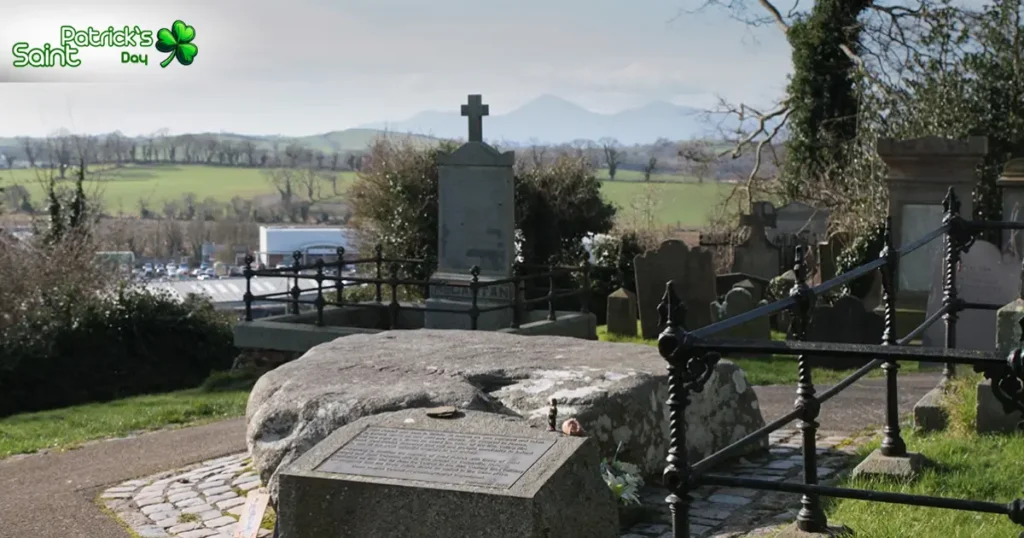
How Is St. Patrick’s Grave Preserved?
To maintain this historic landmark, the Church of Ireland and local heritage groups have taken steps to preserve it:
✔ Restoration of Down Cathedral – Regular maintenance of the church and surrounding area.
✔ Protection of the Granite Stone – Preventing erosion and damage to the grave marker.
✔ Educational Initiatives – The Saint Patrick Centre offers historical education programs.
✔ Government and Tourism Support – Funding and conservation efforts by Northern Ireland’s government.
Threats to the Site
⚠ Weather Erosion – Rain and wind can affect the grave marker.
⚠ Tourist Foot Traffic – Large visitor numbers may cause wear on historical elements.
⚠ Urban Development – Expansion of nearby areas must be carefully managed.
Future Plans for Preservation
🔹 Improved Visitor Facilities – Better pathways and signage for tourists.
🔹 Digital Documentation – 3D mapping of the site for historical records.
🔹 Sustainable Tourism Initiatives – Efforts to balance tourism with preservation.
Conclusion
St. Patrick’s final resting place at Down Cathedral, Downpatrick, remains one of Ireland’s most sacred and visited landmarks. His legacy lives on through religious devotion, Irish heritage, and global celebrations.
From pilgrims and historians to tourists and spiritual seekers, millions visit St. Patrick’s grave to pay tribute to the saint who changed Ireland forever.
FAQs
Downpatrick was an important religious center in Ireland, and it is believed that his followers chose the site to honor his missionary work.
Saint Patrick is believed to be buried at Down Cathedral in Downpatrick, Northern Ireland, according to historical and traditional accounts.
While some debate exists, Down Cathedral is the widely accepted burial site, marked by a large granite stone placed in the 19th century.
Yes, St. Patrick’s grave is publicly accessible at Down Cathedral in Downpatrick, where visitors can explore the site and learn about his legacy.
According to tradition, Saint Brigid and Saint Columba are also buried in the same location, making it a significant pilgrimage site.
Related Post
- How Did Saint Patrick Die?
- Was St. Patrick Italian? The Truth Behind His Origins
- The Best St. Patrick’s Day Quotes for Luck & Joy in 2025
- Guinness Beer Bread Recipe for St. Patrick Day 2025
- Best St. Patrick’s Day Games for All Ages in 2025
